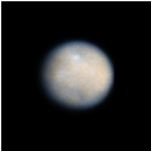Minor Planets or Asteroids - Their History and Classification
Defining Asteroids/Minor Planets
The celestial objects which are smaller than major planets but larger than comets are called asteroids. Like other solar bodies they too revolve round the Sun. Alternatively they are known as minor planets or planetoids. The shape of a minor planet is found by studying the changes in the intensity of light reflected by them. Larger ones are spherical in shape, where as the small ones are tend to be elongated. The chemical composition of each minor planet is different as their parental body is different.
History and Classification of Minor Planets
The image above is that of Ceres taken by Hubble Telescope in 2007_._
In 1801 Giuseppe Piazzi discovered the minor planet Ceres. It was the first minor planet to be discovered. After that, a number of minor planets were discovered including 4-Vesta, 2-Pallas, 12-Victoria, and 433-Eros. Due to the large population of the minor planets the naming of them became a herculean task. So scientists invented a naming strategy, where a number is assigned to the object once the orbit of the newly found minor planet is determined, which may or may not be followed by a name. For example, Pluto is now named 134340. The presence of the minor planets are most prominent in the main asteroid belt, which lies between that of Mars and Jupiter, but they are also found in orbits which stretch beyond that of Neptune.
The International Astronomical Union in 2006 proposed a new classification for minor planets. According to the IAU**,** minor planets and comets were grouped into two categories, namely dwarf planets and small solar system bodies. Those celestial objects that can reach hydrostatic equilibrium under their own gravity and result in an ellipsoidal shape are called dwarf planets; those objects that are not ellipsoidal**,** including comets, are known as small solar system bodies.
The minor planets are classified into different groups according to the position of their orbit. They can be an Asteroid, a Centaur or a Trans-Neptunian object. Those which fall in the group of Asteroids are again divided into Main Belt Asteroid, Near Earth Asteroid and Jupiter Trojans. The minor planets in the Main Belt Asteroids are in an orbit which lies between that of Mars and Jupiter. Near Earth asteroids are found in orbits which are inside that of Mars. Near Earth asteroids can be further defined as Aten, Amor, and Apollo depending on the position of its orbit in comparison with that of the Earth. Jupiter Trojans move in the orbit of Jupiter and are under the influence of Jupiter’s gravitational field. Centaurs are found in unstable orbits which lie between that of Jupiter and Neptune. Trans–Neptunian objects are found in an orbit which is beyond that of Neptune.
Compositional Classification:
The minor planets or asteroids are also classified into three groups in terms of their composition. They are:
- Carbonaceous Asteroids: The majority of asteroids are C types. They have a chemical composition that is high in carbon and may reflect the chemical composition of the primordial solar nebula. The spectral analysis also show the presence of minerals which contain water.
- Silicate Asteroids: They are the second largest group of asteroids. They are rich in silicates. They contain only small traces of carbonaceous compounds and hence, they are believed to have undergone changes from their primitive from.
- Metallic Asteroids: M-type asteroids are the least common and contain iron and nickel .
The minor planets are studied to find more about the origin and evolution of the solar system.
sources
https://en.wikipedia.org/wiki/Asteroid_belt
https://en.wikipedia.org/wiki/Minor_planet
https://www.universetoday.com/guide-to-space/the-solar-system/minor-planets/
https://www.indopedia.org/Asteroid.html
Images
https://www.universetoday.com/guide-to-space/the-solar-system/minor-planets/
